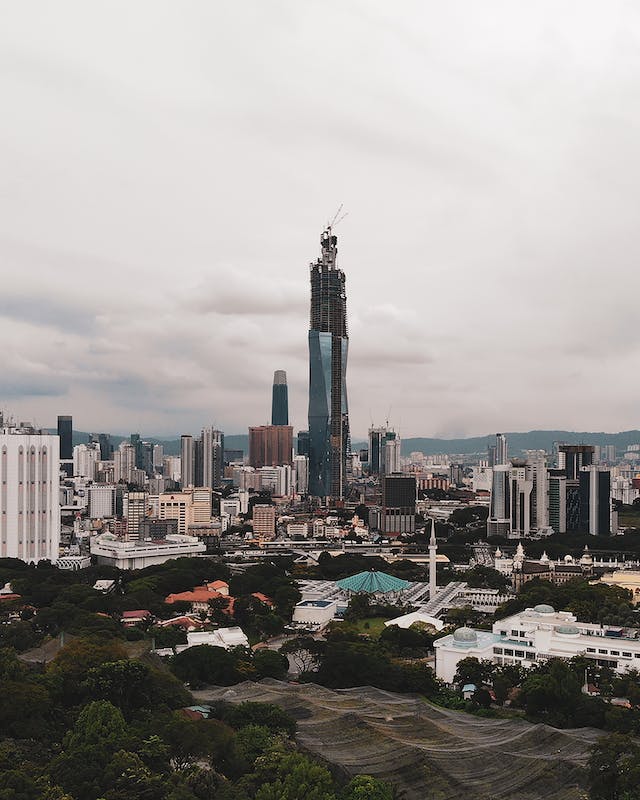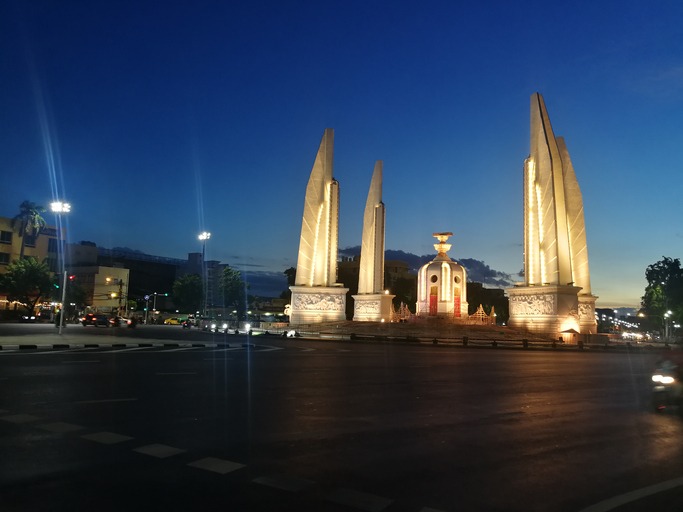For centuries, Thai architecture has served as a symbol of the country and its people’s belief in the importance of community and religion, and the country’s architectural legacy reflects both of these aspects. The architectural traditions of many of Thailand’s neighboring countries have influenced Thailand’s vernacular and religious buildings, which have developed significant regional variation. Despite their efforts to portray themselves as a modernized state, Western culture and influence was unavoidable. Selective Modernization was adopted by Thailand’s ruling elite in an effort to avoid Western influence.
Here are a few of Thailand’s most well-known buildings:
1. Elephant Tower
One of Thailand’s most recognizable and well-known structures, the Elephant Building, also known as the Chang Building, is located in Bangkok’s Chatuchak neighborhood and is known for its elephant-like design. The Elephant Tower was completed in 1997, with a total of 32 floors. The Elephant Tower, a national landmark with three towers forming the shape of an elephant, is one of the world’s most recognizable skyscrapers, ranking among the top five. When you stand on the right side of the building, you can even see the tusk and eye-detailing.
2. Baiyoke Tower II

Want to get a birds-eye view of Bangkok’s splendor? Get away from it all and visit Baiyoke Tower II when you travel. Baiyoke Tower II, an 84-story skyscraper in Bangkok’s Pratunam neighborhood, is one of the world’s tallest buildings. On the 77th floor of the tower, there is a skywalk with large windows from which you can take in the stunning views of the city. Located at 343 meters (1,126 feet), the building is home to a hotel and a shopping complex that opened in 1998. Pratunam market is also popular in the area around the tower, and you can buy a wide variety of goods there.
3. State Tower

State Tower, one of Bangkok’s tallest skyscrapers, is located in the city’s business district on Silom Road. The Dome, Bangkok’s most famous sky bar, is located in the Lebua Hotel, which is housed in the tower. Located on the hotel’s rooftop, the bar’s golden dome and circular seating area have become a landmark in the city. As the sun begins to set, enjoy a cocktail and the changing colors of the sky as the city of Bangkok is illuminated by thousands of lights and lanterns.
4. G Tower
Located at the intersection of Rama IX and Ratchadaphisek, this majestic building is a stunning sight. The first letter of the name of its former owner, G Land, serves as the inspiration for its design (Central Pattana currently owns the building). Built with high-strength steel at the top and an eight-degree tilt in the south tower designed by Urban Architects and KSC & Associates, the office complex is known for its unique cantilevered architecture.
5. Bank of Thailand Learning Center
The former money factory of the Bank of Thailand has been transformed into a learning center, complete with a museum detailing the creation of money, a riverside library housing over 30,000 books, and a coworking space. Membership provides access to over 7,000 digital archives from libraries across the globe.
6. Robot Building
With a striking design that reflects how the banking industry has been influenced by computer technology, the Robot Building, also known as the Bank of Asia, was built in 1987 in Tokyo, Japan. With eyes and antennas, it appears to be a robot’s view of the world. UOB has a presence here as does, among other things, its main office.
7. White Temple
The White Temple, also known as Wat Rong Khun, is a notable landmark in Thailand. One of the temple’s most recognizable features is its white, fairy-tale-like structure, which is adorned with numerous sculptures and gates. The golden structure, the rebirth cycle bridge, the meditation hall, the ubosot (ordination hall), and the portal to heaven are all part of the complex. One of the best places to go in Thailand, thanks to its unique features and enviable location.
8. Sanctuary of Truth
344 feet (104 meters) in height, the Sanctuary of Truth in Pattaya, Thailand, is a unique structure made entirely of teakwood. Intricately detailed scenes, elephants, people and mythical characters from Thai folklore are all depicted in the renowned monument, which is an homage to Thai craftsmanship. Several Hindu and Buddhist architectural elements can be found throughout the museum. Chinese, Cambodian, Indian, and Thai myths and legends are represented in the building’s four corners by a variety of figurines.
9. Wat Chedi Liam
The Wat Chedi Liam Buddhist temple is located in Wiang Kum Kam, one of Thailand’s most historic towns. In the year 1288, the temple was built. The town in which the structure is situated was built by the Lanna Empire’s king, King Mengrai, and is an ancient and fortified one. As of 1296, Wiang Kum Kam served as Lanna’s capital before the discovery of Bangkok. There are still monks living in this active temple, known as the temple of the square chedi. Wat Ku Kham Luang is another name for the complex, which includes a ubosot, a chedi, and a viharn called Mon Dvaravati.
10. King Mahanakhon
At the top of King Mahanakhon’s skyscraper, visitors can enjoy a view of Bangkok and the surrounding area. This building is located in the heart of Bangkok’s Silom business district, next to the BRT and Bangkok Skytrain. Because of its shape, the building takes full advantage of its stunning city views and tropical surroundings.
11. Jim Thompson House
Jim Thompson House, one of Thailand’s most popular tourist attractions, is located in the heart of Sia, between MBK Center and Siam Paragon, surrounded by lush greenery. Teak houses built in the style of traditional Thai architecture make up this museum. This period’s way of life is depicted through the inclusion of historical artifacts and décor.
12. The Grand Palace
The Grand Palace was built in 1785 by King Phutthayotfa Chulalok or Rama I, the first king of the Chakri Dynasty, as the official residence of the Thai kings. The palace’s architectural styles have changed over time because of its renovations. One of Thailand’s most popular tourist attractions, the royal residence is a classic example of dynastic architecture in Thailand. It’s interesting to note that it’s still used on an annual basis for certain royal ceremonies.
13. Phanom Rung
Phanom Rung is Thailand’s best-preserved and most impressive Khmer Hindu temple complex, dating back over a thousand years and perched on the rim of an extinct volcano at 402 meters above sea level. Visitors today enter the site via a 160-meter-long processional walkway that provides stunning views of the temple’s main tower as they approach. In order for the King to get ready for the temple ceremonies, workers built a pavilion on the right side of the walkway for him. Once you’ve walked the entire path, you’ll come to the Naga Bridge, which symbolizes your transition from this world to the next.
14. Central Embassy
Central Embassy, the high-end shopping complex designed by Amanda Levete Architects, is located on the lower floors of the posh building. It houses global luxury brands like Chanel, Saint Laurent, Ralph Laurent, and Prada, as well as more budget-friendly options like Zara, Uniqlo, and Muji. Eathai, a popular Thai food court, is located in the basement, while Open House, a book and food shop, is located on the sixth floor.
15. Wat Plai Laem
Located on the north coast of Koh Samui, Wat Plai Laem is a sprawling complex of Buddhist temples that incorporates a wide range of artistic and architectural flourishes. Despite the fact that the temple is only a few decades old, the techniques used in its construction date back thousands of years. Upon entering Wat Plai Laem, visitors are greeted by an 18-armed white statue of Guanyin, the Buddhist goddess of compassion and mercy. Visit Wat Plai Laem, which sits on the shore of a lake filled with colorful tropical fish.

